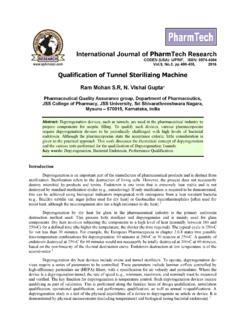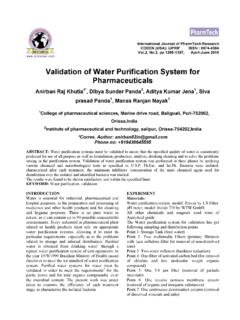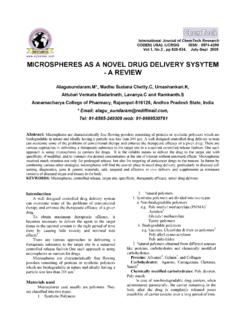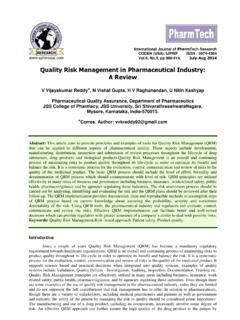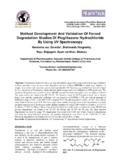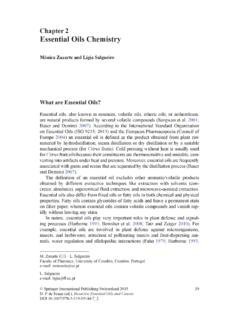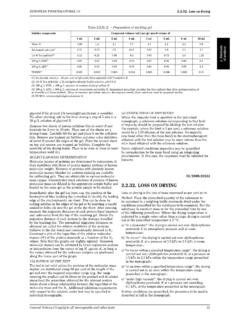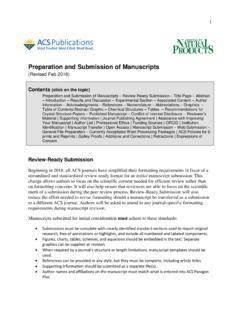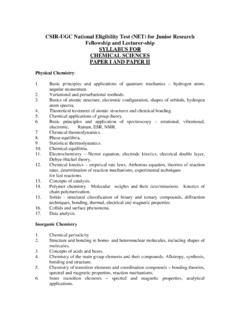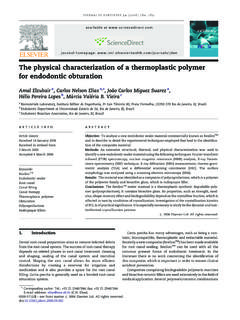Transcription of Synthetic of Phthalimides via the reaction of …
1 International Journal of ChemTech Research CODEN( USA): IJCRGG ISSN : 0974-4290 , , pp 324-333, Jan-March 2014 Synthetic of Phthalimides via the reaction of phthalic anhydride with amines and evaluating of its biological and anti corrosion activity Khuluod Fahed Hamak* Chemistry Department, College of Science Damascus University, Damascus, Syria * : Abstract: A series of phthalimide (I-VI) were prepared in satisfactory yields by reaction of phthalic anhydride with amines(amino pyridine,5-methyl amino pyridine,4-methyl amino quinolin ,aminobenzotiazol,4-amino antipyrine, fluoren-9(9aH)-ylidene)hydrazine) The structure of synthesized has been established on the basis of their spectral (FT-IR ,Mass ,1H,13C-NMR,elemental analysis ) data.
2 The purity of the compounds was confirmed by TLC. The structures of all the compounds were in good agreement with elemental analysis and spectral data. The synthesized compounds were screened for their antibacterial activity against four microorganisms Staphylococcus aureus, Bacillus. subtilis, Escherichia Coli and Klebsiella pneumonia and they were found to exhibit good to moderate antibacterial activity, these compounds were tested to determine their ability to inhibit corrosion of mild steel in 1 H2SO4. Keywords: phthalic anhydride ,amines , Phthalimides , antibacterial activities, anticorrosion, mild steel. Phthalimide and N-substituted Phthalimides are an important class of compounds because they possess important biological activities including anti-inflammatory activity1, analgesic activity2 and hypolipidemic activity3, and also it is used in organic synthesis and other industrial fields such as in drugs synthesis for the acetylenic Phthalimides showed pharmaceutical activity to be anticholinergic agents and anti-Parkinsonian agent4,5A survey of the literature has revealed that Phthalimides derivative and analogues of their potential in a number of areas such as amino piptidase inhabitation6 anticonvulsants activity7 and promotion of tumor necrosis factor alpha (TAIF alpha)
3 Production8 Many amides can be used for the preparation of Synthetic polymers, which can be used as insulating coating in electrical equipment9 and plastic heat resistant glass fiber10 A number of imides also can be used as plant growth regulators and some of them are usefully as herbicides11,12 also some of them have been employed as inhibitors against mammalian, plant, bacterial and fungal copper-containing amine oxidases13. Whereas other substituted Phthalimides demonstrated inhibitory effect on the tested microorganisms14,15, moreover they also employed as prevulcanization inhibitor used in sulphurcured rubber polymer systems16. In view of interesting range of the products from the reaction of Phthalic anhydride with heterocylces amines, it was decided to prepare these compounds by an alternative rout in order to confirm the various structures The Khuluod Fahed Hamak ChemTech ,6(1), pp 324-333.
4 325 following synthesis was carried out by using phthalic anhydride instead of phthal aldehyde The chemical structures of the synthesized compounds were confirmed by means of UV, IR, 1H-NMR.,LC-Ms, Elemental analysis, The synthesized compounds were screened for antibacterial activity against Staphylococcus aureus, Bacillus. subtilis, Escherichia Coli and Klebsiella pneumonia, And the inhibiting action of compounds on the corrosion steel in 1M H2SO4 solution has been investigated. The electro chemical techniques such as polarization measurements were used in this study .Differences in behavior of inhibitors were explained based on structural properties of investigated inhibitors. The course of reaction and Purity of the compounds was checked by TLC and iodine as the visualizing agent.
5 ,Melting points were measured by Electrothermal 1A9000 Digital-Series Melting point Apparatus and are uncorrected. FT-IR spectra were recorded on SHIMADZU FTIR 8400 Fourier Transform Infrared spectrophotometer as KBr disc. 1 HNMR and 13C NMR spectra were recorded on Bruker specrospin ultra shield magnets 300 MHz instrument using tetramethyl silane (TMS) as an internal standared and DMSO-d6 as a solvent, Elemental analysis was performed on a Heraeus CHN-O rapid analyzer,The ESI+VE MS spectra were recorded on a Bruker Daltonics LC-MS spectrometer . spectra were obtained from Shimadzu is spectrophotometer in CHCl3. Methods of preparation: :Synthesis of N- substituted phthalicarboximide : Phthalic anhydride ( , mole) and ( , )amiopyridine,( , )4-methylamino pyridine ,( gr, ) 4-Methylamioquinolin, ( , )2-aminobenzothiazol,( , )4-aminoantipyrine,( , ) fluoren-9(9aH)-ylidene)hydrazine, were refluxed in (50 ml) acetic acid for 4 hour The reaction mixture was filtered off while hot and the solvent was evaporated The solid separated was filtered and recrystallized from ethanol17-19.
6 Scheme. (1). The physical properties, elemental analysis data and spectral data shown in Tables (I,II,III,IV). and Discussion: The product (I-IV) was formed from the reaction of one molecule of phthalic anhydride for mole of amine. The infrared of products exhibited characteristic peak at cm-1 due to ( C=O) group and no absorption band due to NH2 group. Compound (V) show two absorption at ( ) cm-1 due to (C=O) group of phthalic in addition to absorption at ( ) cm-1 due to (C=O) of antipyrine group. Compound (VI) show absorption at ( ) cm-1due to (C=N). The UV spectra of compounds showed max at 298-316. 1H-NMR for compounds (I-VI)show single signal at ( ppm) due to aromatic proton of phthalic . 1H-NMR for compounds (II,III)show single signal at ( , ) due to(CH3) group,also 1H-NMR for compounds (V) show single signal at ( , ) due to(CH3) group and 1H-NMR for compound (VI) show signals at ( ppm) due to aromatic proton of a cridine ring 13C-NMR of compounds (I-VI) showed signals at ( ) due to aromatic carbons of phthalic anhydride and signal at ( ) due to Imidic C=O.
7 13C-NMR spectrum of compound (I) showed signal at ( , , , ) due to aromatic carbons of pyridine, 13C-NMR spectrum of compound (II) showed single signal at ( ppm) due to CH3 group , and signal at ( , ,123, , ) due to aromatic Carbone of pyridine 13C-NMR spectrum of compound (III) showed single signal at ( ) due to (CH3-Ar) and signal at ( , , , , , ,144, , ) ppm due to aromatic carbons of Khuluod Fahed Hamak ChemTech ,6(1), pp 324-333. 326 aromatic ring of (quinoline) 13C-NMR spectrum of compound (IV) showed signals at( , , , , ,149ppm) due to aromatic carbons of spectrum of compound (VI) showed single signals at( , ) due to CH3 group and signal at ( ) due to (C=O) and signals at ( , , , ppm) due to aromatic carbons ofdimethyl-2-phenyl-pyrazol-3-one, 13C-NMR spectrum of compound (V) showed signal at( , , , 128, ,143, ppm) due to aromatic carbons of fluorine20-21.
8 NOOO+H2 NOONNNOOO+H2 NOONNCH3CH3 OOO+H2 NOONNCH3 OOO+OONNSONNCH3H3CH2N+OOOONNCH3H3 COONIIIIIIIVVNSH2 NNCH3 OOONNH2 VIOONN Scheme 1. :Synthesis of Phthalimide compounds(I-VI) Khuluod Fahed Hamak ChemTech ,6(1), pp 324-333. 327 Table (I) : Physical properties of compounds ( I-VI) . Comp. No. structure (0C) Yield ( %) Molecular Weight Molecular formula color (CHCl3) max (nm) I OONN 228 75 C13H8N2O2 White 298 II OONNCH3 172 50 C14H10N2O4 White 298 III OONNCH3 199 42 C14H10N2O4 White 304 IV OONNS 248 70 C15H10N2O2S White 314 V ONNCH3H3 COON 212 75 C19H15N3O3 White 288 VI OONN 266 79 326 C21H14N2O2 Red 316 Table (II) FT-IR Spectral data for compounds (I-V) Comp. No. (C H ) cm-1 (C=C) cm-1 C=O Others I II III IV V (C=O), VI (C=N) Khuluod Fahed Hamak ChemTech ,6(1), pp 324-333.
9 328 Table (III) Depicted Elemental Analysis ( ) of synthesis Compounds compounds Calc. Found H% N% C% H% N% C% I II III IV V VI Table (IV) 1H-NMR and 13C-NMR spectral data for some of the prepared compounds. Compd. No. Compd. Structure 1H-NMR spectra data 13C-NMR spectra data I OONN 1H-NMR: , , , (4H,Ar-pyridine), (4H,Ar-phthalic) 13C-NMR , , , (5C,Ar-pyridin) ,132, , (6C,Ar-phthalic), (2C,2C=O) II OONNCH3 1H- (s,3H,CH3-Ar), (d,1H,Ar-pyridin) , (s,1H,Ar-pyridin) , (d,1H,Ar-pyridin) , (4H,Ar-phthalic) 13C- (CH3-Ar) , , ,123, , ( 5C,Ar-pyridin ), , (6C,Ar-phthalic) , (2C,2C=O) III OONNCH3 1H-NMR: (s,3H,CH3), , , , , (m,4H,Ar), (m,4H,Ar) 13C-NMR: (CH3-Ar) , , , , , ,144, , (9C,Ar), ,132, (6C,Ar-phthalic) (2C,2C=O) IV OONNS 1H-NMR: , , , (4H,Ar), (4H,Ar-phthalic) 13C-NMR: , , , , ,149(6C,Ar), , ,132(6C,Ar), (2C,2C=O) V ONNCH3H3 COON 1H-NMR.
10 (s,3H,CH3), (3H,CH3-N), , , (5H,Ar), (4H,Ar-phthalic) 13C- (1C,CH3-N) , (1C,CH3), (C-C=O) , (CH3-C-N) , (C=O), (2C,2C=O) , , , , (6C,Ar), ,132, ( 6C,Ar-phthalic ) VI OONN 1H- , , (8H,Ar-fluorene), (4H,Ar-phthalic) 13C- , , , 128, ,143, (12C,Ar) , (C,C=N), , 132, (6C,Ar-phthalic) ,168(2C,2C=O) Khuluod Fahed Hamak ChemTech ,6(1), pp 324-333. 329 activity The antimicrobial activity of both categories of compounds was determined by the disc diffusion method22. The in vitro antimicrobial activity was carried out in two gram positive bacteria, and two gram negative bacteria The gram positive bacteria used were Staphylococcus aureus and Bacillus subtilis, gram negative bacteria used were Escherichia coli and Klebsiella pneumonia The compounds were tested at a concentration of 100 g/ml in Dimethylsulfoxide.
